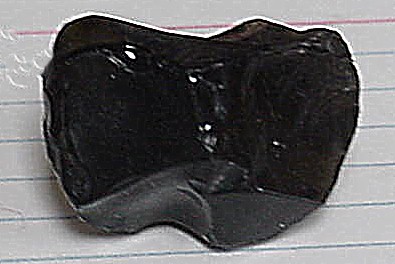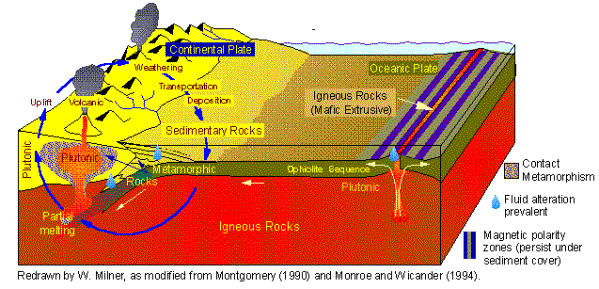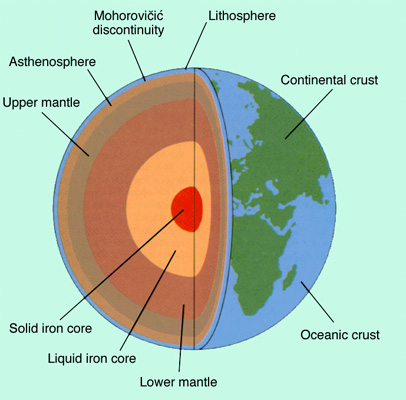| A | B |
|---|
| Micas | Group of silicate minerals characterized by perfect sheet or scale cleavage resulting from atomic pattern, in which silicon-oxygen tetrahedra linked in sheets. Biotite is ferromagnesian. Muscovite is potassic. |
| Elements | Unique combinations of protons, neutrons, and electrons that cannot be broken down by ordinary chemical methods. |
| Minerals | Naturally occurring solid element or compound, exclusive of biologically formed carbon components. Has definite composition or range of composition and orderly internal atomic arrangement (crystalline structure), which gives unique physical and chemical properties, including tendency to assume certain geometrical forms known as crystals. |
| Magma | Naturally occurring silicate melt, which may contain suspended silicate crystals, dissolved gases, or both. These conditions may be met in general by a mixture containing as much as 65 percent crystals but no more than 11 percent dissolved gases. |
| Compound | An electrically neutral substance that consists of two or more elements combined in specific, constant proportions. Typically has physical characteristics different from those of its constituent elements. |
| Igneous Rocks | Aggregate of interlocking silicate minerals formed by cooling and solidification of magma. |
| Extrusive igneous ocks | Rock solidified from mass of magma poured or blown out upon earth's surface. |
| Crystals | Solid with orderly atomic arrangement, which may or may not develop external faces that give it form. |
Obsidian,  | Glassy equivalent of granite. Black glass. |
| Intrusive igneous rock | Plutonic rocks. Rock solidified from mass of magma that invaded earth's crust but did not reach surface. |
Granite,  | Coarse-grained igneous rock dominated by light-colored minerals, consisting of about 50 percent orthoclase, 25 percent quartz, and balance of plagioclase feldspars and ferromagnesian silicates. Granodiorites comprise 95 percent of all intrusive rocks. |
| Clastic evolution | When the energy of the transporting current is not strong enough to carry these particles, the particles drop out in the process of sedimentation. Examples include Breccia. |
| Clastic sedimentary rocks | These rocks are formed when accumulations of stones and smaller pieces of weathered rocks are cemented together naturally. |
| Chemical sedimentary rocks | Rock from chemical processes. Water evaporates, leaving the dissoleved salts on the sea floor. In time, this useful building material was created. |
| Biogenic sedimentary rocks | Rocks formed from living organiszms, such as dolomite and limestone, which was created from timy sea creatures. |
| Compaction | Reduction in pore space between individual grains from pressure of overlying sediments or pressures of earth movement. |
| Clastic sedimentary examples | Examples include sandstone, shale, conglomerate |
| Chemical sedimentary examples | Examples include salt, gypsum, chert or flint, |
| Biogenic sedimentary examples | Examples include limestone and dolomite |
| Limestone | Calcium carbonate cements these fragments together. |
| Metamorphic | One of a set of minerals found in metamorphic rocks and used as indicators of the temperature and pressure conditions at which the metamorphism occurred. A mineral is stable only within a narrow range of temperatures and pressures, and the changes that produces it must take place within that range. |
| Dolomite | Magnesium carbonate cements the biogenic particles together. |
| Metamorphic rock | "Changed-form rock." any rock changed in texture or composition by heat, pressure, or chemically active fluids after original formation. |
| Gneiss | Granite changes into this. |
| Contact metamorphic rocks | Changes as a result of the heat given off during the formation of intrusive igneous rocks. |
| Dynamic metamorphic rocks | Rocks formed when compressed by the weight of rock layers above them or by tectonic forces. |
Rock cycle,  | Rocks are constantly changing in a specific format. |
Asthenosphere,  | A zone within earth's mantle where plastic movements occur to permit isostatic adjustments. Begins 50 to 100 km below surface and extends perhaps to 500 km. |
| Batholiths | A discordant pluton that increases in size downward, has no determinable floor, and shows an area of surface exposure exceeding 100 km2. |
| Precious metals | These metals include gold, silver, platinum |
| Ferrous (with iron) metals | These metals include iron and nickel. |
| Non-ferrous (without iron) metals | These metals include copper, lead and zinc |
| Magnetometers | The world has a relatively static magnetic field, and cultural (and some natural) forces interrupt that field. It surveys measure the irregularities in the magnetic field in a given area. |
| georeferencing | This system is a digital mapping technique in which each point on a map is identified using its exact location on the earth. |
| Placer deposits | Mineral deposits moved from one place and concentrates somewhere else. Can be found where river currents are fast enough to wash away sand. |
| Assayer | Laboratory technician that analyzes geologic materials |
| Economic mineralogist | A person who explores the wealth of the rock before it is mined. |
| Natural gas and oil origins | Plankton is formed in layers millions of years ago. |
| Organiz ooze decomposes slowly | Limited oxygen supply in the layers of rocks. |
| Cap rock | This rock prevents the natural gas from seeping out. |